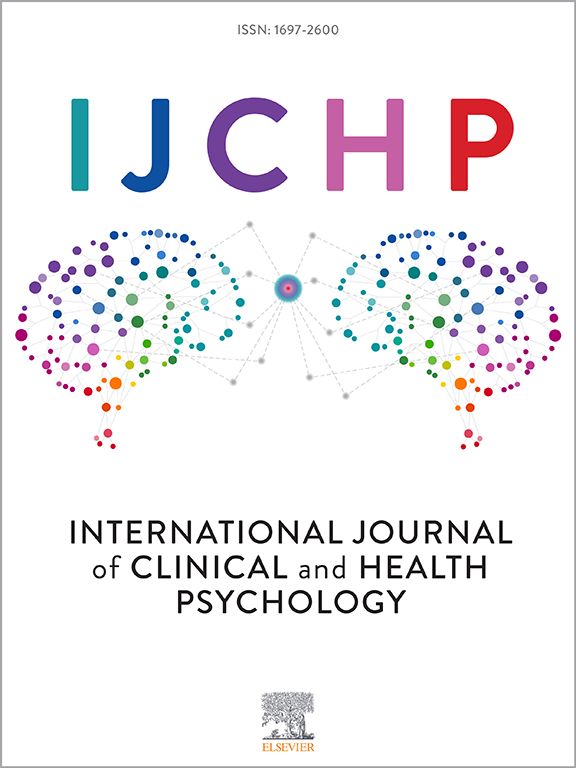Symptom networks and working memory in schizophrenia: a multi-methodological cross-sectional study from phenotype to endophenotype
IF 4.4
1区 心理学
Q1 PSYCHOLOGY, CLINICAL
International Journal of Clinical and Health Psychology
Pub Date : 2025-04-01
DOI:10.1016/j.ijchp.2025.100577
引用次数: 0
Abstract
Background
A notable deficit in working memory (WM) is well established in schizophrenia. Nevertheless, the intricate relationship between various symptoms and WM impairment is still not fully understood. We use three distinct methodologies—symptom network analysis (SNA), Connectome-Based Predictive Modeling (CPM), and brain gene annotation enrichment analysis—to explore the connectome patterns that link WM deficits and symptoms, and their related gene expression.
Methods
255 patients with schizophrenia were recruited as two distinct samples. SNA was used to pinpoint the core psychiatric symptoms influenced by WM performance. CPM identified the subnetwork of the functional connectome that was recruited under the 2-back load of the N-back WM task, and predicted the severity of the SNA-based key symptoms. Gene annotation enrichment analysis explored the likely molecular biological processes underlying the symptom-predictive functional WM network.
Results
SNA revealed that disorganized attention (G11 of PANSS) is most closely linked to WM performance in schizophrenia. The WM-based connectome significantly predicted disorganized attention (r = 0.278, p = 0.001, permutation-p = 0.046), and this model was validated in the second dataset (r = 0.274, p = 0.014). The predictive network primarily involved the frontoparietal and frontolimbic networks. Gene enrichment analysis revealed a preferential role for cytoplasmic protein binding, indicating a potential molecular basis for the WM-related, symptom-predictive functional connectivity.
Conclusions
Impaired WM performance in schizophrenia relates to frontoparietal and frontolimbic connectivity and preferentially influences the severity of disorganized attention, a clinically observable phenomenon. The potential role of cytoplasmic protein binding in WM deficits and attentional disorganization in schizophrenia warrants further investigation.
精神分裂症的症状网络和工作记忆:从表型到内表型的多方法横断面研究
精神分裂症患者存在显著的工作记忆缺陷(WM)。然而,各种症状与WM损伤之间的复杂关系仍未完全了解。我们使用三种不同的方法——症状网络分析(SNA)、基于连接体的预测建模(CPM)和大脑基因注释富集分析——来探索连接WM缺陷和症状的连接体模式,以及它们相关的基因表达。方法选取255例精神分裂症患者作为两个不同的样本。使用SNA确定受WM表现影响的核心精神症状。CPM确定了在N-back WM任务的2-back负荷下招募的功能连接体的子网络,并预测了基于sna的关键症状的严重程度。基因注释富集分析探讨了症状预测功能WM网络可能的分子生物学过程。结果ssna显示,精神分裂症患者注意力紊乱(PANSS的G11)与WM表现的关系最为密切。基于wm的连接组显著预测无组织注意力(r = 0.278, p = 0.001, permutation-p = 0.046),该模型在第二个数据集中得到验证(r = 0.274, p = 0.014)。预测网络主要涉及额顶叶和额边缘网络。基因富集分析揭示了细胞质蛋白结合的优先作用,表明wm相关的症状预测功能连接的潜在分子基础。结论精神分裂症患者WM功能受损与额顶叶和额边缘连通性有关,并优先影响注意力紊乱的严重程度,这是一种可观察到的临床现象。细胞质蛋白结合在精神分裂症患者WM缺陷和注意力紊乱中的潜在作用值得进一步研究。
本文章由计算机程序翻译,如有差异,请以英文原文为准。
求助全文
约1分钟内获得全文
求助全文
来源期刊

International Journal of Clinical and Health Psychology
PSYCHOLOGY, CLINICAL-
CiteScore
10.70
自引率
5.70%
发文量
38
审稿时长
33 days
期刊介绍:
The International Journal of Clinical and Health Psychology is dedicated to publishing manuscripts with a strong emphasis on both basic and applied research, encompassing experimental, clinical, and theoretical contributions that advance the fields of Clinical and Health Psychology. With a focus on four core domains—clinical psychology and psychotherapy, psychopathology, health psychology, and clinical neurosciences—the IJCHP seeks to provide a comprehensive platform for scholarly discourse and innovation. The journal accepts Original Articles (empirical studies) and Review Articles. Manuscripts submitted to IJCHP should be original and not previously published or under consideration elsewhere. All signing authors must unanimously agree on the submitted version of the manuscript. By submitting their work, authors agree to transfer their copyrights to the Journal for the duration of the editorial process.
 求助内容:
求助内容: 应助结果提醒方式:
应助结果提醒方式:


